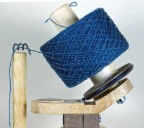Ball Winder Problems
Support
Whenever you have 10,000 of anything in the market, you have a large enough population that you will see just about any problem that can possibly come up. Well, we have seen them all as far as we know.
The HDBW is a mechanical device and it has the ability to create a tremendous amount of force on its components. Fortunately, we designed it to be strong and to withstand these forces over a long period of time. Wear and tear on the unit is limited to certain areas most notably in the areas where we use rubebr o-rings, plastic bearingsm gears, and shafts. Although the wood support structure can expand and contact with environmental conditions (dryness and temperature), wooden components are generally never the cause of any problems (with the possible exception on the Power Base where the electronic membrane switch panel is involved). So, as a rule, the wooden structire is never a problem.
The steel shafts that we use are of a sufficient size (3/8", 10 mm, and 5/16" diameters and these have never bent, deformed so we can rule out probems with steel shafts.
Plastic gears from Switzerland. These are super sturdy. Although we have seen 4 or 5 with broken teeth, these were caused by either a poor meshing of the teeth caused by an alignment problem during early manufacture or the ball winder had fallen off the user's table and landed on the handle which forced the gears to sustain a rapid and severe shock. In all of these cases only 1 gear tooth broke. So, the gears have probven themselves over billions of yards of yarn wound.
Bearing mounts - these are high tech plastic bearings that are essentialy just sleeves for the shafts to run in. These doe not wear apprcialy nor do they fail. They are mounted in the wooden structure and the combination of solid hardwood high quality bearings means they work together for a very long time. Just add some 3-in-1 (machine) oil to the bearing/shaft contact points to prevent squeaks and lubricate the contact surfaces.
Handles - these are tough but can be broken if the user does not clean the ball winder gears out periodically and the gears become jammed with fiber. In certain regions of the world where they use these ballwinders for piece work and they undergo severe handling and are not cleaned out as often as they should be) we modify the handle so that it cannot break. Fo noral users this modifcation is not necessary. We have soeen some failures (~10) where the pneumatic nailer guns that we use fail to place the nails in the correct spot. This is extremely rare, however. Still, the handle is probably the weakest link in the design even though it is super reliable and it is the one item that undergoes all types of mis-treatment by the user.
So the main system, steel shaft, gears,






